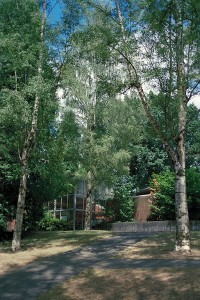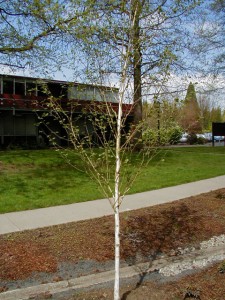Genus: Betula
Family: Betulaceae
Birches are best known for their thin, strong bark that tends to flake off or peel away in sheets like paper. The trees are deciduous and the trunks are generally white or tan. Each tree has both male and female cones, and the female cones fall apart in the fall, releasing hundreds of small winged seeds.
European White Birch
Scientific name: Betula pendula
 The white bark of this birch develops dark splotches with age. Its branches are graceful and pendulous and its bright green leaves turn yellow in the fall. The tree is native to Europe and Asia Minor. In some parts of northern Europe, the sap of the white birch was once brewed into an alcoholic beverage.
The white bark of this birch develops dark splotches with age. Its branches are graceful and pendulous and its bright green leaves turn yellow in the fall. The tree is native to Europe and Asia Minor. In some parts of northern Europe, the sap of the white birch was once brewed into an alcoholic beverage.
View tree page and map.Paper or Canoe Birch
Scientific name: Betula papyrifera
 This tree is found across Canada and the most northern parts of the U.S., but its native range only drops into a small corner of NE Oregon. The trunk has thin, white bark and dark horizontal markings called "lenticels." As the trunk expands, the bark peels away in paper-thin curls (but it should not be pulled off live trees). The tree is sometimes called "canoe birch" because the bark was used by Native Americans for building canoes.
This tree is found across Canada and the most northern parts of the U.S., but its native range only drops into a small corner of NE Oregon. The trunk has thin, white bark and dark horizontal markings called "lenticels." As the trunk expands, the bark peels away in paper-thin curls (but it should not be pulled off live trees). The tree is sometimes called "canoe birch" because the bark was used by Native Americans for building canoes.
View tree page and map.Whitebarked Himalayan Birch
Scientific name: Betula jacquemontii
 This tree, which has the whitest bark of any birch, grows naturally in the western Himalayas. The species name was given to honor Victor Jacquemont, a French naturalist who spent four years traveling and collecting in that area in the 1800s. Some books list this tree as a variety of the Himalayan birch, Betula utilis.
This tree, which has the whitest bark of any birch, grows naturally in the western Himalayas. The species name was given to honor Victor Jacquemont, a French naturalist who spent four years traveling and collecting in that area in the 1800s. Some books list this tree as a variety of the Himalayan birch, Betula utilis.
View tree page and map.